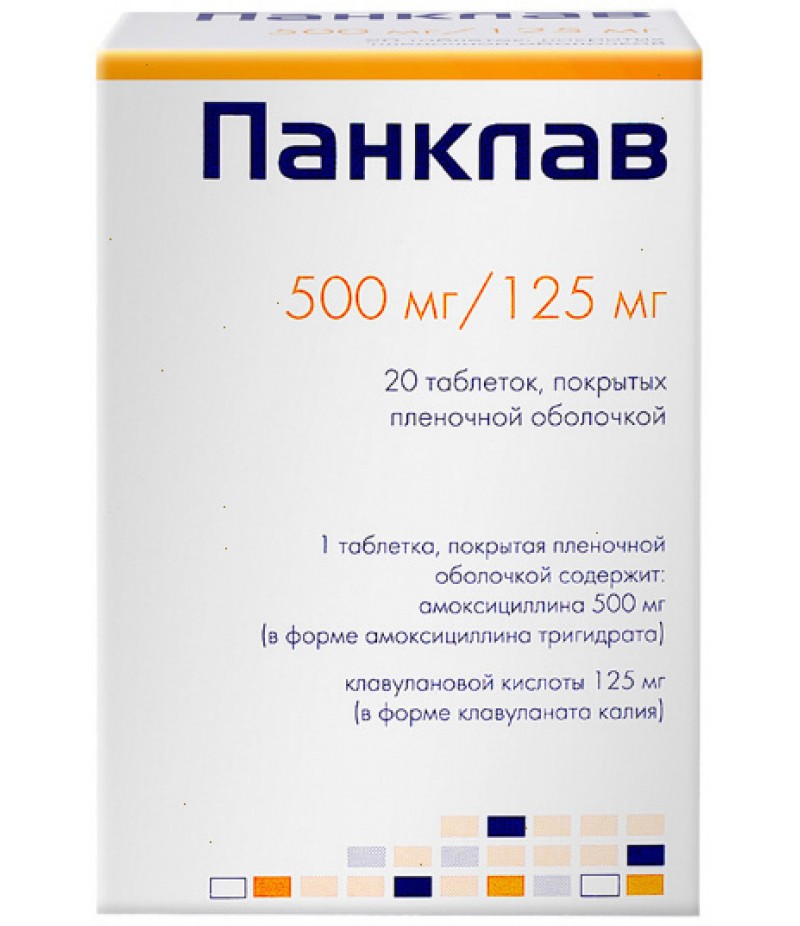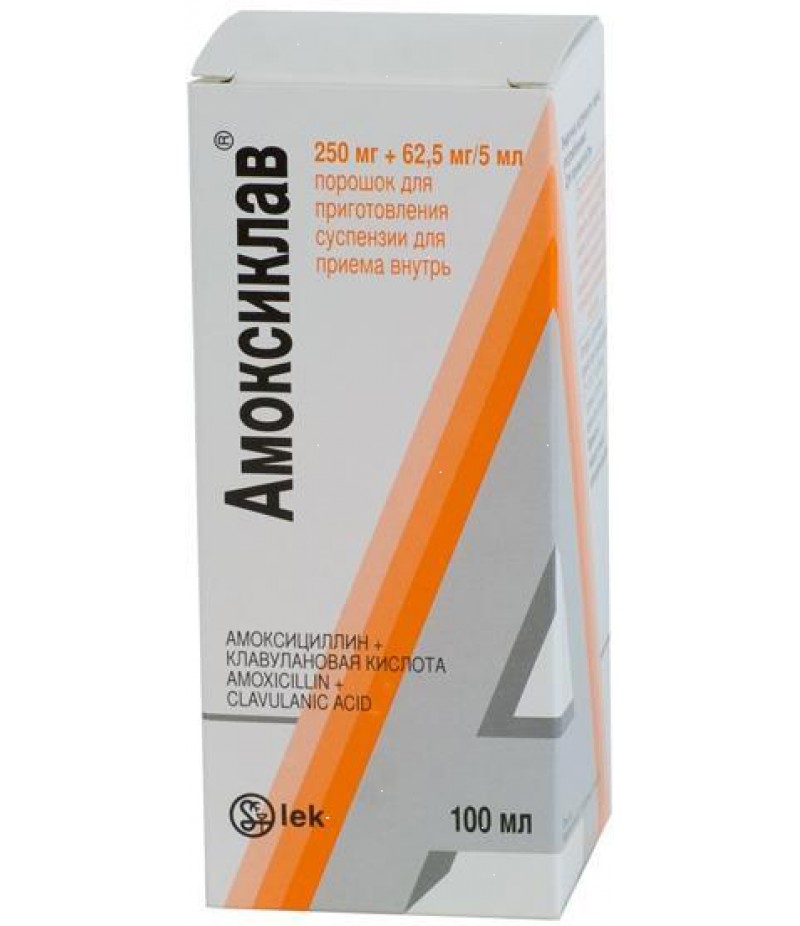Panclav tabs 500mg + 125mg #20
- $24.82
- 3 or more $23.99
- Availability:In Stock
User manual for PanclavReed more and buy Panclav onlineCompositionIn one film-coated tablet is 250/500 mg of amoxicillin in the form of amoxicillin trihydrate, as well as 125 mg of clavulanic acid in the form of potassium clavulan..
Tags: tabs
User manual for Panclav
Reed more and buy Panclav online
Composition
In one film-coated tablet is 250/500 mg of amoxicillin in the form of amoxicillin trihydrate, as well as 125 mg of clavulanic acid in the form of potassium clavulanate. Depending on the dosage of the preparation, the composition of the additional inactive substances and the shell is different:
Dosage of 250 mg: 6.5 mg of colloidal silica dioxide, 13 mg of sodium carboxymethyl starch, 247.7 mg of MCC, 9.75 mg of magnesium stearate; The film-type membrane consists of 13.6 mg of hypromellose, 2.7 mg of propylene glycol and 9.7 mg of titanium dioxide (E171).
Dosage 500 mg: 10.5 mg colloidal silica dioxide, 21 mg sodium carboxymethyl starch, 382.6 mg MCC, 10.8 mg magnesium stearate; The film-type membrane consists of 21.9 mg of hypromellose, 4.4 mg of propylene glycol and 15.6 mg of titanium dioxide (E171).
Form of issue
Tablets (dosage: 250/125 mg and 500/125 mg) in film-type membranes are packed in jars of dark glass at 15, 20 tablets. and sealed in cardboard packs.
pharmachologic effect
Has a bactericidal and antibacterial effect of a wide spectrum.
Pharmacodynamics and pharmacokinetics
Semisynthetic amoxicillin is an antibiotic of the penicillin group with a broad spectrum of action, clavulanic acid is an inhibitor of β-lactamases (except type I). Due to the fact that clavulanic acid forms a strong inactivated complex - amoxicillin is protected from the loss of antibacterial activity associated with the synthesis of β-lactamases - the main pathogens and co-pathogens, as well as conditionally pathogenic microorganisms.
Panclav is active in relation to:
to aerobic Gram-positive bacteria: Streptococcus bovis, Streptococcus pneumoniae, Streptococcus viridans, Streptococcus pyogenes, Staphylococcus aureus (except methicillin-resistant strains), Staphylococcus epidermidis (except methicillin-resistant strains), Enterococcus spp. Listeria spp .;
to aerobic gram-negative bacteria: Brucella spp., Bordetella pertussis, Gardnerella vaginalis, Campylobacter jejuni, Escherichia coli, Haemophilus ducreyi and influenzae, Moraxella catarrhalis, Klebsiella spp., Neisseria gonorrhoeae and meningitidis, Proteus spp., Pasteurela multocida, Vibrio cholerae, Salmonella spp ., Shigella spp., Yersinia enterocolitica;
to anaerobic bacteria: Actinomyces israelii, Peptostreptococcus spp., Peptococcus spp., Bacteroides spp., Clostridium spp.
Data on the pharmacokinetics of Panclav
Both active substances from the digestive tract are absorbed quickly, and the maximum concentration is reached after 1 hour, regardless of meals. Active substances are able to penetrate the placental barrier and GEB of noninflammated brain envelopes. The half-life is within 1-1.5 hours, the excretion occurs through the kidneys mainly in the unchanged form along the path of tubular secretion or glomerular filtration. In small amounts, excretion occurs easily or through the intestine.
Indications for use
The drug is prescribed for infectious and inflammatory diseases of different localization and genesis caused by microorganisms sensitive to active substances:
infectious processes in the skin and soft tissues, including phlegmon, wound infection;
infection of the ENT organs and the upper sections of the airways, including sinusitis, pharyngitis, tonsillitis and otitis media;
infections of the lower parts of the airways, among them, bronchitis, pneumonia, purulent pleurisy;
infectious processes in the urinary tract, including cystitis, pyelonephritis, urethritis;
gynecological infectious diseases, including endometritis, salpingitis, salpingoophoritis, septic abortion;
infections in bone tissue and joints, for example, chronic osteomyelitis;
infectious diseases of the biliary tract, including cholangitis and cholecystitis;
chancroid;
gonorrhea;
infections of the oral cavity (odontogenic).
Contraindications
infectious genesis of mononucleosis (including with korepobodnoj a rash);
age group: up to 12 years;
lactation (for the application it is necessary to solve the problem of stopping breastfeeding);
hypersensitivity to drugs from the group of penicillins, cephalosporins, other β-lactam antibiotics and other components of this drug.
Use with caution
during pregnancy (in the case of potentially greater benefit than risk);
with severe hepatic insufficiency;
with chronic renal failure;
in diseases of the gastrointestinal tract, or in the presence of a history of colitis associated with the use of penicillins.
Side effects
Undesirable manifestations of the digestive tract: diarrhea, nausea, vomiting, increased activity of liver enzymes - transaminase, liver dysfunction, stomatitis; In very rare cases, pseudomembranous colitis, hepatitis, and cholestatic jaundice have been reported.
Allergic manifestations in the form of hives, itchy skin, erythematous rash; rare cases of erythema multiforme, toxic epidermal necrolysis, acute generalized exanthematous pustules, serum sickness, Quincke edema; extremely rare - exfoliative dermatitis, Stevens-Johnson syndrome, anaphylactic shock.
CNS: Some patients have convulsions, dizziness, headache.
Among other negative side effects: candidiasis, superinfection (due to the growth of microflora insensitive to Panclav), reversible increase in prothrombin time, interstitial nephritis, vaginitis.
Panclav, instructions for use (Method and dosage)
Method of taking the tablets: inside, before a full meal. Do not chew and drink a small amount of clean water.
For adults and individuals who have reached the age of 12 years (body weight more than 40 kg) the standard dosage regimen: 1 tablet 250/125 mg three times a day (effective for mild and moderate infectious disease course). For seriously ill patients, the use of tablets 500/125 mg - 1 tablet three times during the day.
Maximum daily doses of active ingredients
Clavulanic acid for adults - 600 mg, for children - 10 mg per 1 kg of body weight.
Amoxicillin for adults - 6 g, for children - 45 mg per 1 kg of body weight.
Duration of treatment
Usually, the therapy is 5-14 days. An individual treatment regimen can be established by the attending physician, however, after 14 days, a second medical examination should be performed.
Treatment of odontogenic infections
Take 1 tablet at a dose of 500/125 mg every 12 hours for 5 days.
Patients with impaired renal function
Mild renal insufficiency (creatinine clearance estimates result in 10-30 ml per minute) - take 1 tablet 500/125 mg every 0.5 days or 1 tablet 250/125 mg twice daily.
Severe renal failure (creatinine clearance estimates result no more than 10 ml per minute) daily dose 1 tablet 500/125 mg or 1 tablet 250/125 mg.
Anuria: the interval between tablets should be increased to 2 days or more.
Overdose
Reaction from the side of the body
The intake of super-doses of Panclav causes nausea, vomiting, and possibly nervous excitement and insomnia. Sometimes an overdose caused convulsive seizures and a shift in the water-electrolyte balance.
Method of treatment
Within 4 hours to wash the stomach, prescribe absorbents, hemodialysis is also effective.
Interaction
In combination with antacids, aminoglycosides, glucosamine, laxatives, the absorption of Panclav is slowed down, with ascorbic acid - it increases.
Panclav with bactericidal antibiotics (including cephalosporins, aminoglycosides, as well as Cycloserine, Rifampicin, Vancomycin) - synergism occurs.
Bacteriostatic drugs (macrolides, lincosamides, tetracyclines, sulfonamides, Chloramphenicol) have an antagonistic effect.
Panclav is able to potentiate the effect of indirect anticoagulants and requires monitoring of blood coagulability (suppression of the intestinal microflora reduces the level of vitamin K secretion, as well as a prothrombin index).
The effectiveness of oral contraceptives and drugs that result from the metabolism of PABC - decreases.
With ethinyl estradiol - increases the risk of bleeding such as "breakthrough".
With diuretics, Allopurinol, Phenylbutazone, NSAIDs and other drugs blocking the tubular secretion, the concentration of amoxicillin increases.
With Allopurinol, the risk of skin rashes increases.
Storage conditions
The best place is protected from light rays and moisture, with an ambient temperature of 15-25 ° Celsius.
For safety reasons, keep medicines out of the reach of children!
Shelf life
Tablets are to be applied for two years when stored in a holistic, original package.
Panclav during pregnancy and lactation
Panclav during pregnancy should be used with caution and only in case of potentially greater benefit than risks for the unborn child.
During lactation for the use of the drug, it is necessary to solve the problem of stopping breastfeeding, since it is excreted in trace concentrations along with breast milk.
Panclav Analogues
Augmentin;
Amoxiclav;
Flemoclav Solutab.
Reviews about Panclav
Comments on the drug are few, but mostly patients leave positive feedback, noting its effectiveness and sparing effect. Despite the fact that it is an antibiotic of a wide spectrum, but does not affect the intestinal flora. Of course, it is not the strongest antibiotic, but it is not necessary in every case.





